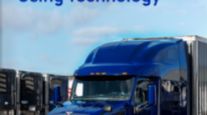Future Trucks to Gain From Advancements in Remote Technologies, OEMs Predict
This story appears in the Dec. 16 print edition of Transport Topics.
IRVING, Texas — The trucks of tomorrow will receive wireless software updates, utilize advanced active safety systems and benefit from additional powertrain integration and aerodynamic improvements, OEM executives told an audience of industry professionals.
Terry Billings, vice president of business development at Volvo Trucks, said improvements in remote diagnostics will speed up the repair and maintenance process.
“We are moving from a reactive situation to proactively fixing the truck,” Billings said during American Trucking Associations’ Executive Summit on Technology-Driven Performance here Dec. 4-6.
In the years ahead, trucks will “self-evaluate” and will be repaired remotely via wireless updates, Billings said.
“We already know that approximately 50% of repairs are software-related, so think about the ability to save downtime and diagnostic repair with self-diagnostics and wireless and remote repairs,” he said.
Manufacturers said fleets also can expect to see efficiency gains through powertrain integration and aerodynamics.
“If you look forward to the greenhouse-gas era of regulation, we’re in a much better time,” said David Hames, general manager of marketing and strategy at Daimler Trucks North America. “We’ve got alignment now between emissions regulations and the fuel-economy goals [fleets] have.”
In response to a question from moderator Howard Abramson, publisher and editorial director of Transport Topics, several of the OEM executives did not express concerns about their ability to meet the 2017 requirements.
“We certified early to the 2014 standard, which requires us to certify early to the 2017 standard,” DTNA’s Hames said. “It’s in the bag for us.”
“I would say the customer pressure on fuel economy has probably outstripped the 2017 standards,” said Dennis Mooney, group vice president of global product development at Navistar International Corp.
Hames said drivetrain integration is “one of the keys to getting to those next steps in vehicle efficiency,” and that means proprietary engines, transmissions and axles.
He also said fleets will continue to move toward automated manual transmissions, not only for fuel-economy improvements, but also to improve driver retention.
Kevin Baney, chief engineer at Kenworth Truck Co., said the industry has made “significant strides” in aerodynamics, but there is room for improvement.
Truck OEMs have worked to optimize the tractor, and suppliers have offered a variety of systems to improve trailer aerodynamics, but the next step is to look at the combined unit, he said.
“There is a lot of improvement that can be made when you look at it as a complete system,” Baney said.
Future aerodynamics also will consider the multivehicle environment through vehicle-to-vehicle technology such as “platooning,” he said.
Baney also said active systems designed to assist the driver will continue to expand.
Looking back at changes in aftertreatment technology, Navistar’s Mooney said the 2007 and 2010 federal emissions standards “really challenged the industry” and led to increased weight, higher costs and more complexity.
“The sad part about that is that’s not aligned with anything any of you want, other than clean air that’s good for society,” Mooney said. “I think that’s going to change a little bit because there’s not as much dialogue about tailpipe pollutants.”
Instead, the focus of the 2014 and 2017 standards has shifted to greenhouse gases, which lines up with the better fuel efficiency that fleets seek, he said.
Prior to the remarks from OEM executives, Paul Menig, CEO of consulting firm Tech-I-M, set the stage with comments about what fleets are looking for in their trucks.
First off, trucks must meet government regulations, “whether we like them or not,” he said.
Fleets also are looking for trucks with a low upfront cost.
The vehicles must be reliable, durable and well-suited to the application, Menig said, adding that only when those conditions are met does the conversation shift to total cost of operation.
Menig also is a member of the future truck committee of the Technology & Maintenance Council.




